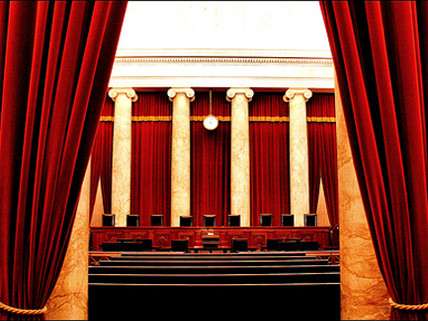Are You Allowed to Vote While Wearing a 'Don't Tread on Me' T-Shirt? SCOTUS Will Soon Decide
The Supreme Court agrees to hear the First Amendment case Minnesota Voters Alliance v. Mansky.

Does the Constitution permit state governments to create "speech-free zones" that ban political attire within 100 feet of a polling place on election day, even if that attire does not mention a candidate, a campaign, or even a political party? Or does the First Amendment protect the citizenry's right to wear such attire while casting a ballot?
The U.S. Supreme Court will tackle those questions later this term when it hears oral arguments in Minnesota Voters Alliance v. Mansky. The justices agreed to take up the case yesterday.
At issue is a Minnesota statute declaring that "a political badge, political button, or other political insignia may not be worn at or about the polling place on primary or election day." The ban applies to all apparel "designed to influence and impact voting" or "promoting a group with recognizable political views."
Andrew Cilek, the executive director of the conservative group Minnesota Voters Alliance, ran afoul of the law in 2010 when he tried to vote wearing a t-shirt adorned with an image of the Gadsen Flag, the phrase "Don't Tread on Me," and a Tea Party Patriots logo. Cilek was also wearing a "Please I.D. Me" button from the conservative group Election Integrity Watch.
Cilek and the Minnesota Voters Alliance, represented by the lawyers at the Pacific Legal Foundation, are now asking the Supreme Court to strike down the Minnesota law. "This Court has never countenanced speech-free zones at polling places," they argue in their briefing. "Rather, it has held that bans on First Amendment activity are unconstitutional, regardless of the forum."
On the opposite side of the case is Joe Mansky, the elections manager for Ramsey County, Minnesota, along with several other state officials. They maintain that the law "is not overbroad but a reasonable and viewpoint neutral regulation of speech in the nonpublic forum of a polling place."
The Supreme Court's key precedent in this area of the law is a 1992 decision known as Burson v. Freeman, in which the Court upheld the constitutionality of a Tennessee statute that created "campaign-free zones" within 100 feet of polling places on election day. That law prohibited "campaign posters, signs or other campaign materials, distribution of campaign materials, and solicitation of votes for or against any person or political party or position on a question."
Mansky and his fellow state officials insist that Burson clearly cuts in their favor. But there is an important difference between that precedent and the present case. Burson dealt only with campaign-related speech. The Minnesota law goes much further, encompassing the far wider category of political speech, including speech that makes no mention of any campaign, candidate, initiative, referendum, or party.
In other words, it's one thing to ban a "Vote for Bernie" shirt from the polling place; it's another thing to ban an "Occupy Wall Street" shirt.
And that is precisely what is at issue here. The same reasoning that would allow Minnesota to prohibit "Don't Tread on Me" shirts from polling places on election day would also allow the state to prohibit AFL-CIO buttons or NAACP hats, to name just a few of the sort of everyday items that Americans wear in order to express their political beliefs or identities.
In an amicus brief filed in support of the Minnesota Voters Alliance, the Cato Institute, Rutherford Institute, Individual Rights Foundation, and Reason Foundation (the nonprofit that publishes this website) argue that the law's extensive reach is a fatal flaw worthy of judicial rectification. "When a statute is written so generally that it could plausibly be enforced against vast swaths of speech," the brief notes, "this Court has applied the doctrine of overbreadth, invalidating the statute for placing too much discretion in the hands of government agents. Minnesota's law, which simply bans 'political' insignia, suffers from precisely this constitutional defect."
We'll find out later this term where the justices stand on the bedrock First Amendment questions raised by this case.




Show Comments (77)